Friday, September 01, 2006
Æ tetradrachm, Alexandria, Salonina, Emmett 3747(7)
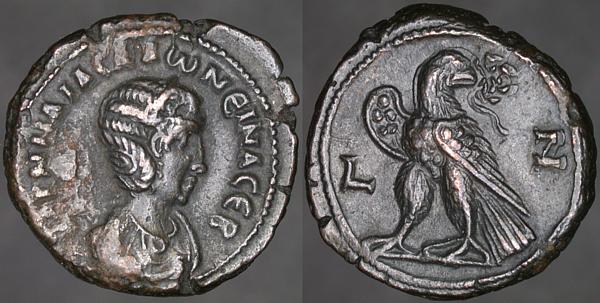
KOPNHΛIA CAΛωNEINA CEB, Diademed draped bust right | L_Z, Eagle standing left, head right, holding wreath.
As I mentioned on Tuesday, the coins of Roman Egypt are well-cataloged and have a consistent logic not seen with other provincial coinage: Roman Egypt had a closed economy neither honoring coins from outside the province nor permitting export of its own except for regulated taxed money-changing operations.
The coins of Roman Egypt are also dated with the emperor's regnal date which appeals to those who took up collecting as children, collecting from pocket change, where assembling a long run of years is an assumption of how the hobby works.
Thursday, August 31, 2006
Billon antoninianus, Gallienus, Rome, Göbl 398c
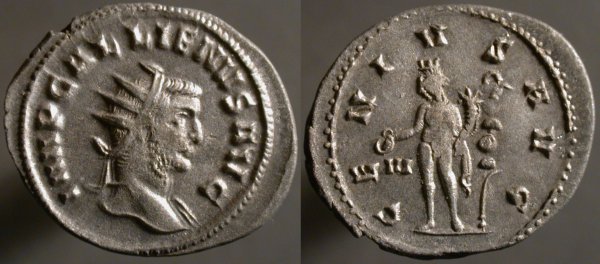
IMP GALLIENVS AVG, Radiate head right, slight drapery on both shoulders | GENIVS AVG, Genius standing left, holding patera in right hand and cornucopia in left. Standard right. VI in left field.
Serendipity: just as with Monday's coin, but not received by me until after Monday's post was written, this reverse with this obverse is attested by Göbl in only a single example (single examples are also attested with a draped bust and with a left-facing martial bust similar to this). The plate in the catalog shows an example inferior to this, which is nice for me: I've got the best example I know of. Yay, me!
Genius here refers not to an ancient Einstein but to a protective, tutelary, spirit who is depicted carrying the patera of sacrifice to the gods and the cornucopiae of their beneficence, wearing a radiate crown like Sol and standing next to a military standard.
Wednesday, August 30, 2006
Æ3, Valens, uncertain mint, uncertain #
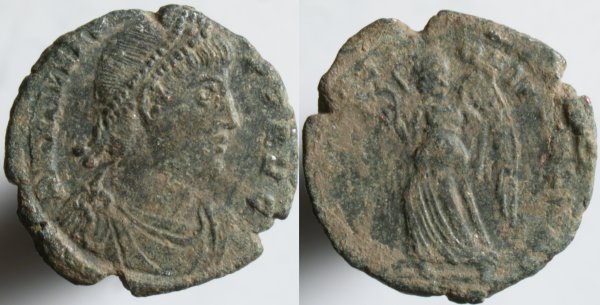
D N VALENS P F AVG, Diademed draped bust right | SECVRITAS REPVBLICAE, Victory advancing left holding wreath before.
Flavius Iulius Valens was the brother of Valentinian and was made emperor by him in 374. His career, as was usually true for 4th Century emperors, was a series of wars against usurpers, Goths, and Persians and, in peacetime, his support for the Arian heresy, which was all the rage in those days.
Successful if uninspired, Valens had time run in 378 out for himself and most of his army fighting against Goths at Hadrianopolis in Thrace (modern-day Edirne, in Turkey.
I was surprised to see that this unimpressive coin, filler in a multi-coin lot, was the most presentable I had of Valens. I'm not in any frenzy to obtain a better one.
Tuesday, August 29, 2006
Æ28, Magydos in Pamphylia, Salonina, Imhoff ZGURM p.176
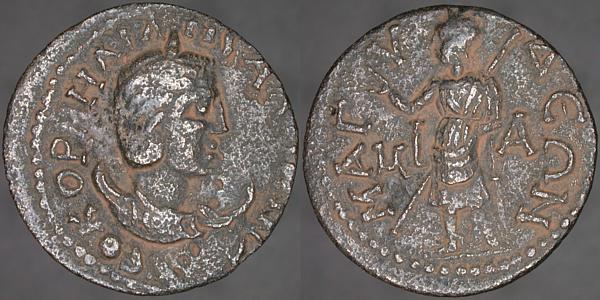
KOPNHΛIA CAΛΩNINA CE, Diademed draped bust right on crescent, small orb beneath | MAΓ_V_ΔEΩN, Demeter? standing left, hand raised left, holding long transverse scepter. MI_A across fields.
One of the downsides of the fascination with having the rare coin simply because it is rare that yesterday evidenced is pieces like this, or worse: unlovely coins that've suffered in 1,700 years or so lying in the ground. Still, adequate detail in the folds of drapery on Demeter (or whoever is seen here) which makes for a more appealling sight than a coin worn flat after many years of use.
For the first year, and a bit more, that I collected Gallienus, I avoided provincial coins, beleiving them ugly and impossible to collect them in a logical way: there is no single volume that catalogs all provincial coins.
In time, I succumbed to the spell of coins from Roman Egypt, which have been well-cataloged and which present questions for which answers can usually be found. From there, though, it was a short step to the imponderables of hundreds of civic coinages.
Monday, August 28, 2006
Silvered Æ antoninianus, Gallienus, Antioch, Göbl 1634f
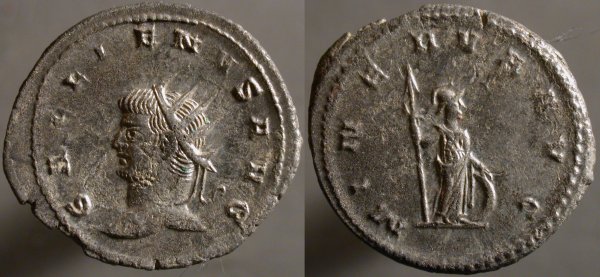
GALLIENVS AVG, Radiate head left | MINERVA AVG, Minerva standing right, holding spear left and shield right.
As I begin writing a post, the most common first line that occurs to me is “This is an interesting one”, but I refrain, remembering to how few people it's likely to be so interesting.
One of the things that interests me is that Göbl attests only a single example of this reverse matched with this bust. He includes a photograph of that example, which is not of this coin: while Göbl found only one example in the various catalogs of collections, sales, and auctions that he knew, a second example has surface, and it's in my hands.
Now, interest in Gallienus or in his generally wretched coinage is so restricted that this piece of great rarity cost no more than a few nice lunches, nor did it attract any special interest. If it featured an unpublished reverse design, unlike any common coin, there would be interest, but only a specialist collector cares about a fairly common reverse with a faily common obverse, rare only because the two are paired. (And I know most of the collectors in this specialty, even if only as eBay userids.)

